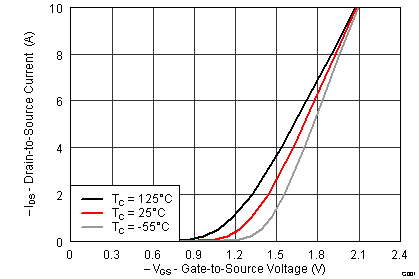SLPS512A July 2014 – May 2017 CSD75208W1015
PRODUCTION DATA.
- 1Features
- 2Applications
- 3Description
- 4Revision History
- 5Specifications
- 6Device and Documentation Support
- 7Mechanical, Packaging, and Orderable Information
Package Options
Refer to the PDF data sheet for device specific package drawings
Mechanical Data (Package|Pins)
- YZC|6
Thermal pad, mechanical data (Package|Pins)
Orderable Information
5 Specifications
5.1 Electrical Characteristics
TA = 25°C unless otherwise stated| PARAMETER | TEST CONDITIONS | MIN | TYP | MAX | UNIT | ||
|---|---|---|---|---|---|---|---|
| STATIC CHARACTERISTICS | |||||||
| BVDSS | Drain-to-Source Voltage | VGS = 0 V, IDS = –250 μA | –20 | V | |||
| BVGSS | Gate-to-Source Voltage | VDS = 0 V, IG = –250 μA | –6.1 | –7.2 | V | ||
| IDSS | Drain-to-Source Leakage Current | VGS = 0 V, VDS = –16 V | –1 | μA | |||
| IGSS | Gate-to-Source Leakage Current | VDS = 0 V, VGS = –6 V | –100 | nA | |||
| VGS(th) | Gate-to-Source Threshold Voltage | VDS = VGS, IDS = –250 μA | –0.5 | –0.8 | –1.1 | V | |
| RDS(on) | Drain-to-Source On-Resistance | VGS = –1.8 V, ID = –1 A | 100 | 150 | mΩ | ||
| VGS = –2.5 V, ID = –1 A | 70 | 88 | mΩ | ||||
| VGS = –4.5 V, ID = –1 A | 56 | 68 | mΩ | ||||
| RD1D2(on) | Drain-to-Drain On-Resistance | VGS = –1.8 V, ID1D2 = –1 A | 190 | 285 | mΩ | ||
| VGS = –2.5 V, ID1D2 = –1 A | 120 | 150 | mΩ | ||||
| VGS = –4.5 V, ID1D2 = –1 A | 90 | 108 | mΩ | ||||
| gfs | Transconductance | VDS = –2 V, ID = –1 A | 7.5 | S | |||
| DYNAMIC CHARACTERISTICS | |||||||
| CISS | Input Capacitance | VGS = 0 V, VDS = –10 V, ƒ = 1 MHz |
315 | 410 | pF | ||
| COSS | Output Capacitance | 132 | 172 | pF | |||
| CRSS | Reverse Transfer Capacitance | 7.7 | 10 | pF | |||
| Qg | Gate Charge Total (–4.5 V) | VDS = –10 V, IDS = –1 A |
1.9 | 2.5 | nC | ||
| Qgd | Gate Charge, Gate-to-Drain | 0.23 | nC | ||||
| Qgs | Gate Charge, Gate-to-Source | 0.48 | nC | ||||
| Qg(th) | Gate Charge at Vth | 0.31 | nC | ||||
| QOSS | Output Charge | VDS = –10 V, VGS = 0 V | 2.1 | nC | |||
| td(on) | Turn On Delay Time | VDS = –10 V, VGS = –4.5 V, IDS = –1 A, RG = 0 Ω |
9 | ns | |||
| tr | Rise Time | 5 | ns | ||||
| td(off) | Turn Off Delay Time | 29 | ns | ||||
| tf | Fall Time | 11 | ns | ||||
| DIODE CHARACTERISTICS | |||||||
| VSD | Diode Forward Voltage | IDS = –1 A, VGS = 0 V | –0.75 | –1 | V | ||
| Qrr | Reverse Recovery Charge | VDD = –10 V, IF = –1 A, di/dt = 200 A/μs | 4.3 | nC | |||
| trr | Reverse Recovery Time | 9 | ns | ||||
5.2 Thermal Information
TA = 25°C unless otherwise stated| THERMAL METRIC | MIN | TYP | MAX | UNIT | |
|---|---|---|---|---|---|
| RθJA | Junction-to-Ambient Thermal Resistance (1) (2) | 165 | °C/W | ||
| Junction-to-Ambient Thermal Resistance(2) (3) | 95 | ||||
(1) Device mounted on FR4 material with minimum Cu mounting area
(2) Measured with both devices biased in a parallel condition.
(3) Device mounted on FR4 material with 1-inch2 (6.45-cm2), 2-oz. (0.071-mm thick) Cu.
 |
Typ RθJA = 95°C/W when mounted on 1 inch2 (6.45 cm2) of 2-oz. (0.071-mm thick) Cu. |
 |
Typ RθJA = 165°C/W when mounted on minimum pad area of 2-oz. (0.071-mm thick) Cu. |
5.3 Typical MOSFET Characteristics
(TA = 25°C unless otherwise stated)

| ID = –1 A | VDS = –10 V | ||

| ID = –250 µA | ||

Gate-to-Source Voltage



| VDS = –5 V | ||


Gate-to-Source Voltage

| ID = –1 A | ||

| Single Pulse, Max RθJA = 165°C/W | ||
